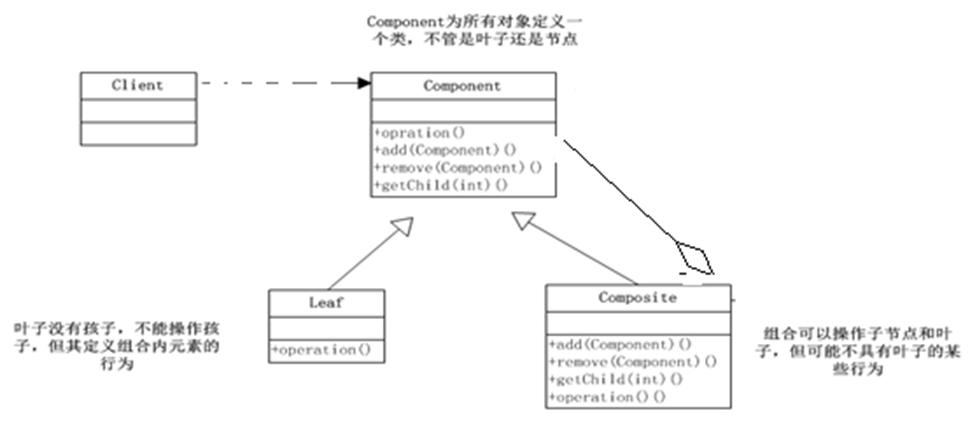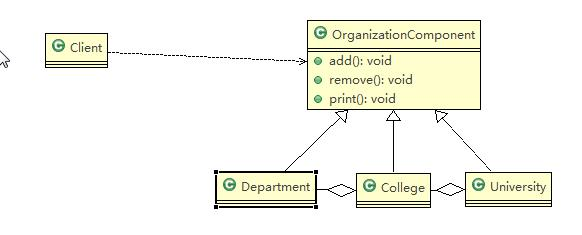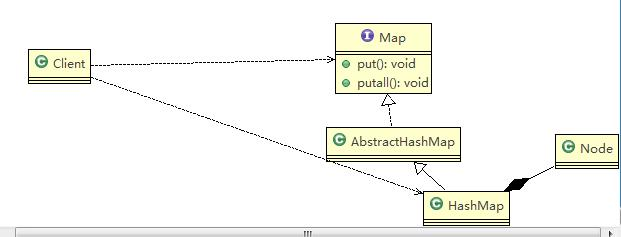组合模式
一、应用实例
编写程序展示一个学校院系结构:要在一个页面中展示学校的院系组成,一个学校有多个学院,一个学院有多个系。
二、组合模式(Composite Pattern)
1.基本介绍
1)组合模式,又叫部分整体模式,将对象组合成树状结构。
2)组合模式使用户对单个对象和组合对象的访问具有一致性
2.原理类图

1)Component:这是组合中对象声明接口,在适当情况下,实现所有类共有的接口默认行为,用于访问和管理Component子部件,Component可以是抽象类或者接口
2)Leaf:在组合中表示叶子节点,叶子节点没有子节点。
3)Composite:非叶子节点,用于存储子部件,
3.组合模式解决学校院系展示的实例
1)分析类图

- 代码实现
public class Client {
public static void main(String[] args) {
//从大到小创建对象 学校
OrganizationComponent university = new University("清华大学", " 中国顶级大学 ");
//创建 学院
OrganizationComponent computerCollege = new College("计算机学院", " 计算机学院 ");
OrganizationComponent infoEngineercollege = new College("信息工程学院", " 信息工程学院 ");
//创建各个学院下面的系(专业)
computerCollege.add(new Department("软件工程", " 软件工程不错 "));
computerCollege.add(new Department("网络工程", " 网络工程不错 "));
computerCollege.add(new Department("计算机科学与技术", " 计算机科学与技术是老牌的专业 "));
infoEngineercollege.add(new Department("通信工程", " 通信工程不好学 "));
infoEngineercollege.add(new Department("信息工程", " 信息工程好学 "));
//将学院加入到 学校
university.add(computerCollege);
university.add(infoEngineercollege);
//university.print();
infoEngineercollege.print();
}
}
public abstract class OrganizationComponent {
private String name; // 名字
private String des; // 说明
//方法print, 做成抽象的, 子类都需要实现
protected abstract void print();
protected void add(OrganizationComponent organizationComponent) {
//默认实现
throw new UnsupportedOperationException();
}
protected void remove(OrganizationComponent organizationComponent) {
//默认实现
throw new UnsupportedOperationException();
}
//构造器
public OrganizationComponent(String name, String des) {
super();
this.name = name;
this.des = des;
}
public String getName() {
return name;
}
public void setName(String name) {
this.name = name;
}
public String getDes() {
return des;
}
public void setDes(String des) {
this.des = des;
}
}
//University 就是 Composite , 可以管理College
public class University extends OrganizationComponent {
List<OrganizationComponent> organizationComponents = new ArrayList<OrganizationComponent>();
// 构造器
public University(String name, String des) {
super(name, des);
}
// 重写add
@Override
protected void add(OrganizationComponent organizationComponent) {
organizationComponents.add(organizationComponent);
}
// 重写remove
@Override
protected void remove(OrganizationComponent organizationComponent) {
organizationComponents.remove(organizationComponent);
}
@Override
public String getName() {
return super.getName();
}
@Override
public String getDes() {
return super.getDes();
}
// print方法,就是输出University 包含的学院
@Override
protected void print() {
System.out.println("--------------" + getName() + "--------------");
//遍历 organizationComponents
for (OrganizationComponent organizationComponent : organizationComponents) {
organizationComponent.print();
}
}
}
public class College extends OrganizationComponent {
//List 中 存放的Department
List<OrganizationComponent> organizationComponents = new ArrayList<OrganizationComponent>();
// 构造器
public College(String name, String des) {
super(name, des);
}
// 重写add
@Override
protected void add(OrganizationComponent organizationComponent) {
// 将来实际业务中,Colleage 的 add 和 University add 不一定完全一样
organizationComponents.add(organizationComponent);
}
// 重写remove
@Override
protected void remove(OrganizationComponent organizationComponent) {
organizationComponents.remove(organizationComponent);
}
@Override
public String getName() {
return super.getName();
}
@Override
public String getDes() {
return super.getDes();
}
// print方法,就是输出University 包含的学院
@Override
protected void print() {
System.out.println("--------------" + getName() + "--------------");
//遍历 organizationComponents
for (OrganizationComponent organizationComponent : organizationComponents) {
organizationComponent.print();
}
}
}
public class Department extends OrganizationComponent {
//没有集合
//add , remove 就不用写了,因为他是叶子节点
public Department(String name, String des) {
super(name, des);
}
@Override
public String getName() {
return super.getName();
}
@Override
public String getDes() {
return super.getDes();
}
@Override
protected void print() {
System.out.println(getName());
}
}
四、组合模式在JDK集合的源码分析
1)HashMap使用了组合模式
2)源码分析

五、组合模式的注意事项
1)具有较强的扩展性。当我们要更改组合对象时,只要调整内部的层次关系,客户端不用做出任何改动。
2)需要遍历组织机构,或者处理的对象具有属性结构时,非常适合使用组合模式
3)要求较高的抽象性,如果节点和叶子有很多差异性的话,比如很多方法和属性都不一样,不适合使用组合模式